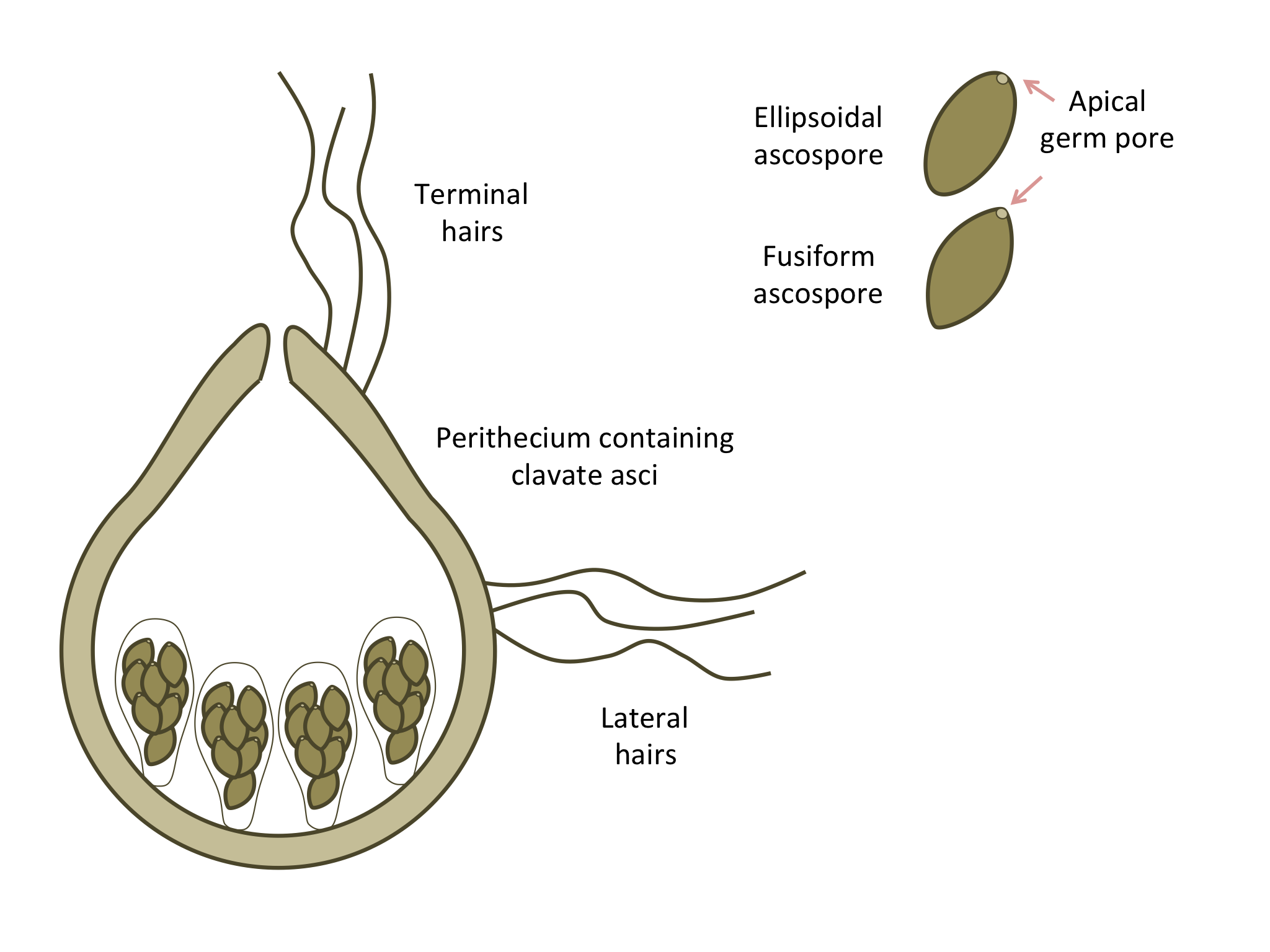Chaetomium Cellulolyticum on:
[Wikipedia]
[Google]
[Amazon]
''Chaetomium'' is a  Members of this genus typically have superficial, ostiolar perithecia, covered in hairs. Asci are often clavate and evanescent, bearing eight spores. Ascospores are usually lemon-shaped, commonly colored olive-brown. Mycelia often grows in conglomerate masses that resemble ropes.Chivers, A. H. (1915). "A monograph of the genera ''Chaetomium'' and ''Ascotricha''". ''Mem. Torrey Bot. Club'' 14: 155-240.
As well as being a contaminant, ''Chaetomium'' spp. are also encountered as causative agents of infections in humans. Many cases cause type 1 allergic reactions and infections. A few cases of fatal deep infections due to ''Chaetomium atrobrunneum'' have been reported in immunocompromised people. Other clinical syndromes include brain abscess,
Members of this genus typically have superficial, ostiolar perithecia, covered in hairs. Asci are often clavate and evanescent, bearing eight spores. Ascospores are usually lemon-shaped, commonly colored olive-brown. Mycelia often grows in conglomerate masses that resemble ropes.Chivers, A. H. (1915). "A monograph of the genera ''Chaetomium'' and ''Ascotricha''". ''Mem. Torrey Bot. Club'' 14: 155-240.
As well as being a contaminant, ''Chaetomium'' spp. are also encountered as causative agents of infections in humans. Many cases cause type 1 allergic reactions and infections. A few cases of fatal deep infections due to ''Chaetomium atrobrunneum'' have been reported in immunocompromised people. Other clinical syndromes include brain abscess,
genus
Genus (; : genera ) is a taxonomic rank above species and below family (taxonomy), family as used in the biological classification of extant taxon, living and fossil organisms as well as Virus classification#ICTV classification, viruses. In bino ...
of fungi in the Chaetomiaceae family. It is a dematiaceous (dark-walled) mold
A mold () or mould () is one of the structures that certain fungus, fungi can form. The dust-like, colored appearance of molds is due to the formation of Spore#Fungi, spores containing Secondary metabolite#Fungal secondary metabolites, fungal ...
normally found in soil, air, cellulose and plant debris. According to the ''Dictionary of the Fungi'' (10th edition, 2008), there are about 95 species in the widespread genus.
In 1817 Gustav Kunze established the genus ''Chaetomium'' (the plume of the helmet) to classify the species ''C. globosum'' and ''C. elatum''. No further contributions to the genus were made until 1837 when the publication of Corda described its characteristic asci in his work, ''Icones Fungorum Hucusque Cognitorum''. In 1915, Arthur Houston Chivers produced a complete monographic treatment of the genus, recognizing only 28 of the described 114 species.
 Members of this genus typically have superficial, ostiolar perithecia, covered in hairs. Asci are often clavate and evanescent, bearing eight spores. Ascospores are usually lemon-shaped, commonly colored olive-brown. Mycelia often grows in conglomerate masses that resemble ropes.Chivers, A. H. (1915). "A monograph of the genera ''Chaetomium'' and ''Ascotricha''". ''Mem. Torrey Bot. Club'' 14: 155-240.
As well as being a contaminant, ''Chaetomium'' spp. are also encountered as causative agents of infections in humans. Many cases cause type 1 allergic reactions and infections. A few cases of fatal deep infections due to ''Chaetomium atrobrunneum'' have been reported in immunocompromised people. Other clinical syndromes include brain abscess,
Members of this genus typically have superficial, ostiolar perithecia, covered in hairs. Asci are often clavate and evanescent, bearing eight spores. Ascospores are usually lemon-shaped, commonly colored olive-brown. Mycelia often grows in conglomerate masses that resemble ropes.Chivers, A. H. (1915). "A monograph of the genera ''Chaetomium'' and ''Ascotricha''". ''Mem. Torrey Bot. Club'' 14: 155-240.
As well as being a contaminant, ''Chaetomium'' spp. are also encountered as causative agents of infections in humans. Many cases cause type 1 allergic reactions and infections. A few cases of fatal deep infections due to ''Chaetomium atrobrunneum'' have been reported in immunocompromised people. Other clinical syndromes include brain abscess, peritonitis
Peritonitis is inflammation of the localized or generalized peritoneum, the lining of the inner wall of the abdomen and covering of the abdominal organs. Symptoms may include severe pain, swelling of the abdomen, fever, or weight loss. One pa ...
, and onychomycosis
Onychomycosis, also known as tinea unguium, is a fungal infection of the nail. Symptoms may include white or yellow nail discoloration, thickening of the nail, and separation of the nail from the nail bed. Fingernails may be affected, but it is ...
.
Selected species
*'' Chaetomium atrobrunneum'' *'' Chaetomium carinthiacum'' *'' Chaetomium cupreum'' *'' Chaetomium cellulolyticum'' *'' Chaetomium elatum'' *'' Chaetomium funicola'' *'' Chaetomium globosum'' *'' Chaetomium grande'' *'' Chaetomium interruptum'' *'' Chaetomium iranianum'' *'' Chaetomium jatrophae'' *'' Chaetomium megalocarpum'' *'' Chaetomium perlucidum'' *'' Chaetomium rectangulare'' *'' Chaetomium strumarium'' *'' Chaetomium subspirale'' *'' Chaetomium thermophilum'' *'' Chaetomium truncatulum'' *'' Chaetomium olivaceum'' *''Chaetomium undulatulum
''Chaetomium undulatulum'' is a fungus species in the ''Chaetomium'' genus, first isolated from Iran. It shares features such as peridium structure, ascospore morphology and germ pore position with its cogenerates. It is closely related to ''Chae ...
''
References
Sordariomycetes genera {{Sordariales-stub